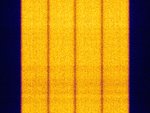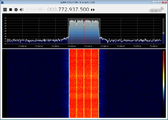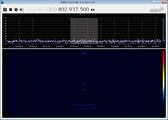Motorola ASTRO 25 HPD Air Interface
 | |
|---|---|
| Frequencies | 769 MHz,775 MHz,851 MHz,869 MHz |
| Frequency Range | 769 MHz - 869 MHz |
| Mode | RAW |
| Modulation | QAM |
| ACF | 120ms |
| Emission Designator | 17K7D7D |
| Bandwidth | 17.7 kHz |
| Location | United States |
| Short Description | Motorola's ASTRO 25 High Performance Data Air Interface allows Motorola ASTRO 25 HPD modems to transfer data at up to 96 kbps over a 25 kHz channel in the 700 MHz or 800 MHz bands. |
| I/Q Raw Recording | Download file |
| Audio Sample | |
Motorola ASTRO 25 High Performance Data (HPD) uses the HPD Air Interface (HAI) to communicate with compatible modems. The modems are used primarily by law enforcement mobile data terminals to communicate with a dispatch center's computer-aided dispatch system. Downlink channels strongly resemble iDEN. The downlink uses four QAMQuadrature Amplitude Modulation channels packed closely together to occupy a 25 kHzKiloHertz (kHz) 10^3 Hz channel, and the uplink uses TDMATime Division Multiple Access. Short blips can be heard on the uplink, and they may not resemble the downlink signal. The downlink signal has a 120ms ACFAutoCorrelation Function with other peaks on multiples of 30ms, and the uplink signal has an ACFAutoCorrelation Function that is a multiple of 30ms (usually 180ms, 360ms, or 420ms).
Most HPD systems use Motorola HPD 1000 modems for subscriber units and Motorola GTR 8000 transmitters for base stations.
Additional Samples[edit]
Frequencies[edit]
In the United States, downlinks are found in the 769-775 MHzMegaHertz (MHz) 10^6 Hz and 851-869 MHzMegaHertz (MHz) 10^6 Hz ranges, and uplinks use standard +30 MHzMegaHertz (MHz) 10^6 Hz or -45 MHzMegaHertz (MHz) 10^6 Hz splits, respectively.

